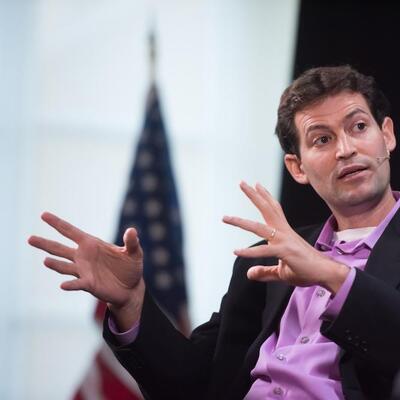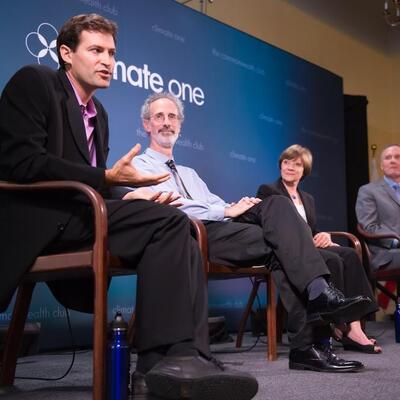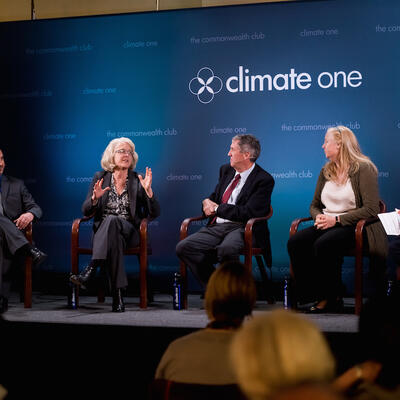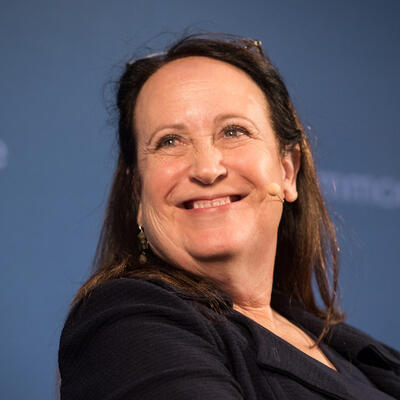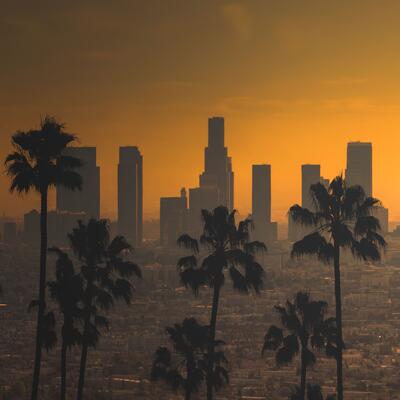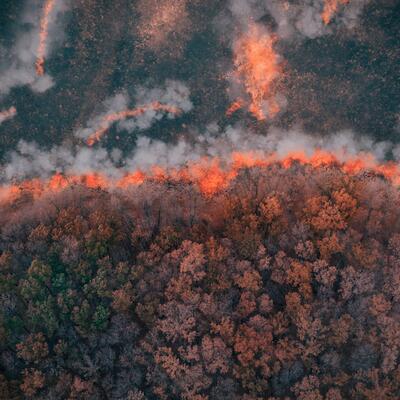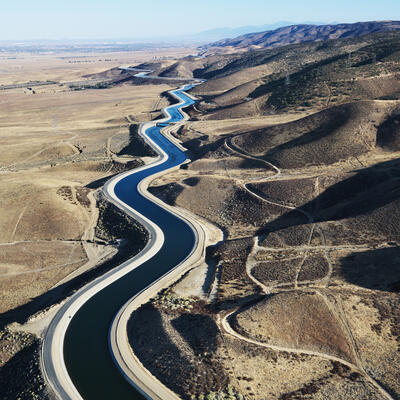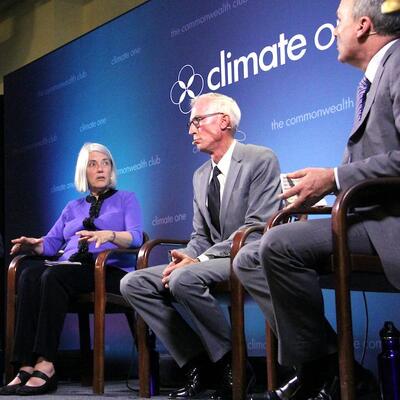
Killing the Colorado
Guests
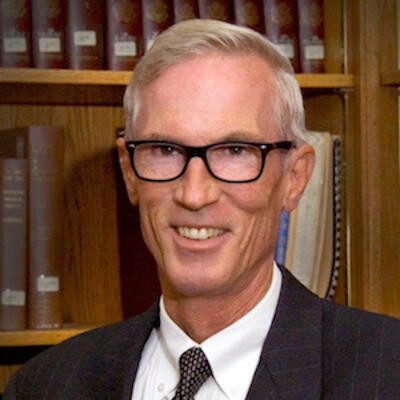
Kevin E. Kelley
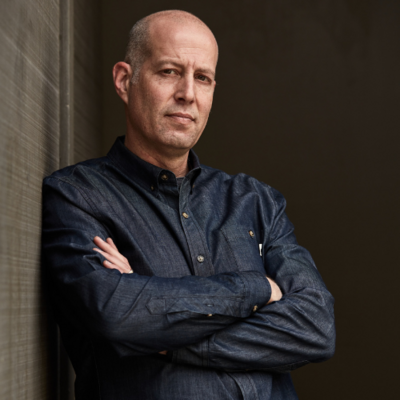
Abrahm Lustgarten
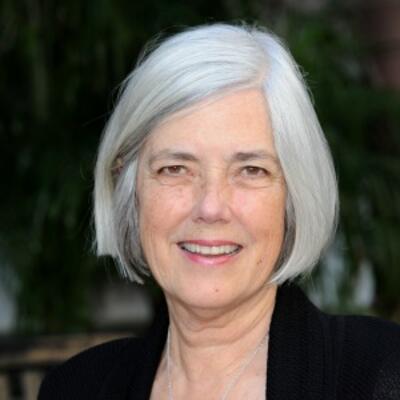
Fran Spivy-Weber
Summary
Every year, 41 million Americans take more water out of the Colorado than nature puts into it. How can we continue to share an ever-shrinking resource?
Kevin E. Kelley, General Manager, Imperial Irrigation District
Abrahm Lustgarten, Reporter, ProPublica
Fran Spivy-Weber, Vice Chair, CA State Water Resources Control Board
This program was recorded in front of a live audience at the Commonwealth Club of California on February 15, 2017.
Full Transcript
Greg Dalton: From the Commonwealth Club of California, this is Climate One changing the conversation about America's energy, economy and environment. I'm Greg Dalton. On the show today, we’re going to explore the Colorado River. Every year, 40 million Americans take more water out of the Colorado than nature puts into it. Although this is a very wet year, the river is in pretty bad shape after 17 years of drought. Many Californians don't realize that a third of the state’s freshwater comes from the Colorado River, which irrigates crops in the Imperial Valley and runs carwashes in Los Angeles.
Over the next hour, we will check in on the Colorado and learn how it's connected to the California State water system including the troubled Oroville Dam near Chico. Joining our live audience at the Commonwealth Club in San Francisco, we are pleased to have with us three experts, Kevin Kelley he is general manager of the Imperial Irrigation District which uses about 20% of all the water flowing down the Colorado River. The desert area in Southern California is home to a billion-dollar agricultural economy that sends a lot of products to our kitchen tables. Abrahm Lustgarten is a reporter with ProPublica. He has written extensively about water in the American West and hosted the Discovery Channel documentary, “Killing the Colorado.” We will hear some voices from that film to animate our discussion today. Fran Spivy-Weber is vice chair of the California State Water Resources Control Board, the main state agency for water in California and previously worked for the National Audubon Society and the Mono Lake Committee. Please welcome them to Climate One.
[Applause]
I’d like to begin, there’s long been tension between folks who believe California, particularly farmers in the Imperial Valley, need to conserve more and share more water. One of our producers spoke to Dave White at the Decision Center for a Desert City in Phoenix to try and give us a sense of where we are today and how California's water use is affecting states throughout the California, Colorado River basin. Let’s hear from him.
[Start Audio Clip]
Dave White: My name is Dave White. I’m a professor at Arizona State University and director of the Decision Center for a Desert City. Lake Mead is approximately 40% of its storage capacity currently. I'm sitting around 1085 feet above sea level. The last time I checked, it's essentially a coin flip, whether the lake level will be below 1075 feet in August when the potential for a shortage declaration would occur.
The winter precipitation has been a positive story. We’re seeing elevated snowpack in the Colorado Rockies and it’s certainly welcome news. On the flipside, we are in the midst of a 16-year long drought in the region and so even in typical or median years for precipitation and inflow into the major Colorado River basin reservoirs, there are greater allocations of water than the natural system can provide.
California is allocated the largest share of water, 4.8 million acre-feet. The entire Colorado River allocation to the state of California is protected under current law, so that even under a shortage California would lose 0% of its water allocation from the river. The agricultural users consume the largest share of the total water supply. And so the conversation about the Imperial Valley as well as the other irrigated agricultural areas in the basin reflects questions that we need to have a more deliberate and more public and more informed discussion about the best and highest uses of our water supplies in these regions. Every sector, agriculture, urban, industrial must make significant conservation gains in the coming decades.
[End Audio Clip]
Greg Dalton: That's Dave White, professor at Arizona State University. Kevin Kelley, he referenced a deal there were some states came together and they drew a line in the sand, so to speak, a 1075 or something like that for the level for Lake Mead. Tell us the story of that deal, why those states did that and what would be the consequence of the cutbacks that might happen this summer.
Kevin Kelley: So those are the 2007 interim guidelines and elevation 1075 is that first trigger in which the junior rights holders would take cuts.
So California is entitled to 4.4 million acre-feet. IID [Imperial Irrigation District] does comprise about 70% of that. But this notion of, you know, the comparative value of water used to grow flatland crops and water that supports the production of silicone chips, it’s curious to me because I wonder who makes that call. And who says that one is more valuable than the other? Certainly you can make a case that there’s more economic output from the silicone production. But for those people that live in the area I represent that alfalfa that goes to feed cattle and produce dairy products, that's an important job and they’d be lost without it.
Greg Dalton: Fran Spivy-Weber, you're in a statewide position that is overseeing regulation and distribution of water. How does the state make those value judgments that Kevin Kelley said between crops and semiconductors?
Fran Spivy-Weber: Well, we try to balance. So we try to not tilt in any particular direction. We balance between agriculture, environment and one thing that was not mentioned in the setup piece and also urban areas as well. And the balancing is kind of like you kind of know it when you see it, but then often have a precise number that goes with it.
And so we have to balance all over the state and this is an area that is getting our attention now and actually for – usually it costs lots of money to do the balancing because if you take water away from someone in order for them to be whole they usually have to build something or operate things in a different way.
Greg Dalton: Abrahm Lustgarten, rivers and waters are often talked about as bank accounts and clearly there is more water being taken out of the Colorado River than goes back in so eventually this bank account is going to run dry. Is it a matter of time and when is that gonna happen?
Abrahm Lustgarten: Yeah, think of it more. The Colorado you can think of it more as a loan, you know, so to back up a distance from that 2007 agreement and really the reason that I began reporting on this. In 1922, Herbert Hoover, Secretary of Commerce, facilitates an agreement between the seven states that share the Colorado River and they estimate based on the historical record how much water they think flows down that river. They come up with this number, 18 million acre-feet. I mean, just focus on the 18 part of that number and what we've seen over the historical average and not just the 17 years of drought but since 1922 to now is that the river has flowed at somewhere around a little over 13 million acre-feet. Over the last 17 years of drought it’s flowed at about 12-1/2 million acre-feet. When we talk about the share that each of the states get - California, Nevada, Arizona, Colorado, Wyoming, Utah –they’re dividing from that whole still 90 years later or whatever we are. And they’ve never adjusted that amount to be sustainable with the amount of water that actually flows into the river.
So the 2007 agreement that we’re talking about a moment ago was one stab, a very modest agreement to say well if, you know, things really get out of control, if we really do, you know, over use this resource to point that it’s nonsustainable will each – here's the order in which we’ll each take a little bit of the hit. Even with that hit it doesn't bring it below the amount of water that’s actually flowing in the river.
Greg Dalton: So Kevin Kelley, it sounds like we’re living on some shaky ground here with the amount of water. There is more water on paper than actually in the river and introduce climate change it just seems like there's some real tough times ahead when this lake continues to drop and things get dicey. Is that fair?
Kevin Kelley: It is fair and what Abrahm is talking about is this notion of a structural deficit. But those seven basin states upper and lower basins have a history of anticipating changes like this even a marked one like climate. And we’re engaged right now in a drought contingency plan that despite the welcome snowpack, not just in California but in the Colorado River watershed, you gotta make up for about 17 years of pronounced sustained drought. And my expectation is that those seven states will do that. And no single water user has more of a stake in the Colorado River delivery system than does IID. And no single agency can have more of an impact at Lake Mead than IID.
Greg Dalton: And are you preparing – first of all, do you accept that climate change is happening and affecting weather patterns?
Kevin Kelley: I don't think there's any question about it. Certainly in the part of the state where we live the summers are inordinately hot already and I'm told that we can expect them to – that the rest of the state and the West will follow suit. I find something a little comforting in that; we’ll all be in it together.
[Laughter]
But what I wanted to say on this is that it's in all these states’ interest to plan ahead for if not a structural deficit at least propping up that lake level so that places like mine that rely exclusively on Colorado River won't be high and dry.
Greg Dalton: So this deal that you referenced in 2007 where the states got together and said, okay if the Lake Mead gets down to this level then this act, these cutbacks have to happen. Was that anticipated to be invoked as early as 2017 or they think that was further out in the future, Fran Spivy-Weber?
Fran Spivy-Weber: I thought it was further out in the future at least according to some of the folks engaged in this. But they had no way of knowing just like we have no way of knowing exactly what the effect of climate change is gonna be on us right now this year.
Greg Dalton: So Kevin Kelley, this is getting drier, more dire, faster than these prudent states you described expected.
Kevin Kelley: It clearly is and I think the most important thing right now for people to know about the Imperial Irrigation District is that for almost 15 years we've been engaged in the nation's largest agricultural turbine water transfer.
Greg Dalton: Tell us the story of that 2003 deal, how that came together and you kind of had a gun to your head by the federal government. But tell us how that came together.
Kevin Kelley: So California had been exceeding its entitlement for a number years, Southern California, not our agency.
[Laughter]
But there was great pressure and a lot of the impetus was from the federal government at the time to get a water sharing agreement among the parties and to settle, you know, disputes. And what they did was they called it quantification settlement agreement and it authorized what became these water transfers that will ultimately transfer up to half a million acre-feet of water from our valley, from our farms and fields, to urban Southern California.
Greg Dalton: So the farms save water, San Diego benefits. Abrahm Lustgarten, is this a model deal for kind of moving water around parts of an increasingly dry state?
Abrahm Lustgarten: Yeah, I think it is actually. I mean, I think it's inevitably the type of thing we’re gonna see in the future. To back up a moment, I mean, there's an unbelievable amount of inefficiency in the way water is used throughout the system. So that ranges from using irrigation ditches that aren’t lined and lose half their water before they get to a farm field in Colorado to the fact that somewhere between 10% and 20% of the entire river’s flow evaporates off the surface of these reservoirs and canals and the massive plumbing system we built. And every single one of those are opportunities to use technology or use investment to recoup some of that water. So to make the same amount of water to go a lot further and that's what this settlement agreement did, it basically had the cities of San Diego, Los Angeles and that broader community pay for some of those upgrades; lined the All-American Canal to reduce some of that seepage into the ground and in exchange they got a share of the savings and a little bit more and it's much more complicated than that.
But that's the basic premise and I think you’re gonna start to see a lot more of that. You're starting to see deals where the Southern California metropolitan area is paying farmers north of IID, in the Blythe area of California to fallow fields in especially dry years. Not all the time, not every farm, not every farmer but an exchange of money in exchange for a change in behavior and that behavior saves some water and then you have the opportunity to redistribute that water. And those sorts of trade-offs I think are part of an increased efficiency that has to happen, that will ultimately happen.
Greg Dalton: And Fran Spivy-Weber, efficiency in a warmer world, there’s more evaporation, we built this great state on a system moving around water that is, Abrahm just said, evaporates and leaks all over the place. What can be done? Is the state doing enough to increase efficiency in this warming world where a lot of water is leaking and evaporating?
Fran Spivy-Weber: The state may not be doing enough and I’ll be the first to say that. But the state is asked to do many, many, many things and it often is very easy for and in fact in the quantification settlement agreement, the state agreed –
Greg Dalton: That’s the 2003 deal with San Diego.
Fran Spivy-Weber: The 2003 deal. The state agreed at the time that it would put up $9 billion, a lot of money. And it was really more money than the state was truly willing to do, at least if we judge by the last nine years of the agreement. And so one lesson learned from this agreement, it definitely is I think it will be a model for the future. But we shouldn't ask an entity that has led a legislature that has a governor that sets up a budget every few years to do something so out of proportion to what they do anywhere else. And the devil is in the details. We should work out as many of those details at the beginning as we can possibly do.
Greg Dalton: So Abrahm Lustgarten, 2003 we all remember we actually had a governor who got tossed out that year. $9 billion, did the politicians sell a deal that they didn't intend to fund, what happened?
Abrahm Lustgarten: So I'm actually not familiar with the intimate details of how politically it was going down at the time. I know it was a hard-fought agreement from all sides. You had IID, you had the cities, you had the state of California, you had the other states with a side interest, all really at loggerheads over this agreement. And you had the federal government stepping in and saying, you’re gonna figure out, you’re gonna sign, whatever it is you’re gonna sign, you’re gonna sign it by this date or we’re just gonna cut your water off. So it was a very uncomfortable agreement I think for all sides. I know what the details were for –
Greg Dalton: Kevin Kelley.
Kevin Kelley: I can help just a little bit in the setup on that and I’ll try not to dominate the discussion. But the QSA –
Greg Dalton: The 2003 water deal.
Kevin Kelley: Yeah. So those water transfers to the coast that I talked about, that eventually a ramp up, they’ll represent about half a million acre-feet of water which is a lot of water, that was an accommodation that was hard-fought and it ended up, if you would’ve put that to a vote in our valley at the time, it would've been soundly defeated.
Now, in retrospect, it anticipated an awful lot of what we face today and it was probably farsighted. But it is still very unpopular because in our Valley that water goes to grow food and fiber and it supports the jobs in a very disadvantaged community. But there was a little problem with that QSA, those water transfers, and that’s called the Salton Sea. And the Salton Sea is California's largest lake, it’s sometimes called an accidental lake, but for those of us who live there it's too big to ignore. And this water transfer agreement did its best to ignore it. So we’re now about a year away from the mitigation water that is meant as part of the water transfers to stabilize the shoreline. That water goes away and the Salton Sea starts to recede dramatically after that.
Greg Dalton: And let's get into that. We want to take a listen to an interview from the documentary Killing the Colorado that Abrahm Lustgarten put together. And this is Allison Vessey [ph], a registered nurse at Central Union high school. She says she's already seeing the consequences of the Colorado River drying up relative to the Salton Sea. Let’s listen to Vessey.
[Start Audio Clip]
Allison Bessie: I work in a school district with 200 I would say with asthma, you know, that’s a lot of kids. We have cabinets in each school site with filled with, you know, inhalers because it means it will save their lives. And we have really bad dust, dirt, wind, storms, I mean, where you can’t even hear at our household, we’ll look out and you can’t even see past the fence.
[End Audio Clip]
Greg Dalton: That's Allison Bessie talking about dust storms coming off the Salton Sea. And we have another clip. This is a film of Tom Loyola, a farmer in the Imperial Valley discussing the future of farming there relative to the Salton Sea.
[Start Audio Clip]
Tom Loyola: If we were to dry it up leftover pesticides, where is all that gonna go if the Salton Sea dries up? You know, it’s gonna come this way with the winds and what’s it gonna do? It’s gonna ruin people’s lives and livelihood and the farming here because it will contaminate the soil. So those are just some of the issues that I know that they’re gonna be able to work out. We pray that they'll be able to work those things out.
Interviewer: What will happen if they don’t to you guys then?
Tom Loyola: I don't think you’ll see agriculture in Imperial Valley. I think it'll go back to desert.
[End Audio Clip]
Greg Dalton: That’s a farmer in the Imperial Valley. Abrahm Lustgarten, why don’t you set up for us how the Salton Sea is basically agricultural runoff that's the sort of water from farms there and what he's talking about, which is the potential that all this dust could create this big dustbowl that might return that farmland to desert.
Abrahm Lustgarten: Yeah. It's a complicated story. The Colorado River is essentially a large plumbing system. We’ve built canals and pipelines, moved water hundreds of miles out of its natural course. And the Imperial Valley during exceptional periods of flow going way back in history, hundreds of years in history, would occasionally flow out of its river structure and hat overflow would fill a lake in a place that is now the Salton Sea and is the Imperial Valley. It would periodically fill up, dry up, disappear. When we engineered and built the Colorado River system that we have now, we built a canal that moved to the Colorado River water 80 miles, I think, over a small mountain range and into the Imperial Valley.
And it was used to irrigate this great farming community, 3 million acres I think, correct me Kevin, but all that water after the irrigation has to go somewhere and it drained into that same sort of low spot, geographic low spot in that valley where the Salton Sea originally was and it for a while maintained this the sort of false sea that doesn't have a natural inflow and doesn't have a natural outflow. The problem is that the agricultural irrigation brought with it an enormous amount of pesticides and other materials that just became more and more concentrated, it's essentially waste that flows into the Salton Sea. The water evaporates increasing the concentration of the chemicals and waste that’s left over and it’s sort of a sump for the valley, if you will.
Fran Spivy-Weber: It is a sump for the valley, but I think the focus on the sea as a potential problem as it dries up, is real.
Greg Dalton: That nurse is saying it's more than potential. It’s happening now.
Fran Spivy-Weber: Okay. But what is happening right now is not the sea drying although some areas of the sea have dried up. There is dust in that region. There is dust in Mexico that comes into the region. There is dust in many, many areas. And so I think the point that we are in right now is that the problem is big but like climate change, which is a big problem, all of us have a role to play and I think the Imperial area, the irrigation district started us down that path by coming up with a 10-year plan rather than a 75-year plan that was – called for a smaller sea.
But we can start building wetlands and habitat around that sea to dampen the potential and probable destruction that will come from that.
Greg Dalton: Kevin Kelley, pick up there because if the sea is smaller there is more dust, that creates health problems and you heard that farmer it could cause far trouble for the very farmers that you're irrigating. What’s the solution?
Kevin Kelley: So I don't think that any reasonable person would disagree that hydrology of the Colorado River as it is today will not support a Salton Sea the size that it is today. At IID we've been calling for a smaller but sustainable Salton Sea, a sea perhaps two-thirds the size that it is today. And it is true that outside of the cultivated farmlands our valley is entirely surrounded by desert. So the wind blows and you’re subject to the winds. But as the Salton Sea recedes and it's going to recede dramatically in the next five to 10 years, there has got to be a coherent strategy for how you deal with that emissive lake bed.
Greg Dalton: You think renewable energy is part of that?
Kevin Kelley: I think renewable energy ought to be part of that toolbox.
Greg Dalton: Geothermal in particular, not putting solar panels over the seabed.
Kevin Kelley: I think that as with water in which, you know, the last hundred years has been about moving it to population centers from where it was, the next hundred years we ought to start thinking about moving populations to where the water is. And I think that the Salton Sea is a big a body of water but it's not the intractable problem that we’re gonna have to spend $9 billion on. We just have to decide that in a region like that where we’re trying to do many things at once at a public policy level that we ought to try and make the area better. And so that's our interest.
Greg Dalton: Kevin Kelley is general manager of the Imperial irrigation District in Southern California. Other guests today at Climate one are Abrahm Lustgarten, reporter with ProPublica and Fran Spivy-Weber who’s vice chair of the California State Water Resources Control Board. I'm Greg Dalton. You can join this conversation using our Twitter handle @climateone and listen to podcasts in iTunes at climateone.org.
We’re gonna go to our lightning round and ask our guests yes or no, true or false questions designed to push them to the edge of their comfort zone. True or false Abrahm Lustgarten, growing food in the desert is crazy.
Abrahm Lustgarten: True with a lot of caveats. Can I offer them?
Greg Dalton: Fran Spivy-Weber, Lake Oroville went from the poster child of the droughts to the poster child of having too much water at once.
Fran Spivy-Weber: True.
Greg Dalton: Kevin Kelley, you are disappointed we had so much rain this year because that takes the pressure off hard decisions that are more likely to be made in dry times.
Kevin Kelley: I want to answer his question.
[Laughter]
Greg Dalton: I bet you’d answer no.
Kevin Kelley: I’d answer no.
Greg Dalton: So this question, are you disappointed we had so much rain because that takes the pressure off of hard decisions?
Kevin Kelley: I’m not disappointed that there’s been at least some respite from this prolong drought.
Greg Dalton: Is it true though that this state is more likely to make hard decisions in dry times?
Kevin Kelley: I think that, you know, we all benefit from a little urgency.
Greg Dalton: Abrahm Lustgarten, supposed you’re writing a movie script about water power and politics in California kind of a new Chinatown with Kevin Spacey playing the villain. What agency or industry would that villain represent?
Kevin Kelley: He's a pistachio farmer.
Greg Dalton: Ooh picking on, usually we get almonds get rough tough here. Pistachios take that, okay, pistachios is the new almonds. Kevin Kelley, fracking for natural gas may have serious impacts on food safety and human health?
Kevin Kelley: Since geothermal has nothing to do with fracking. I would say, yes.
Greg Dalton: Kevin Kelley, burning fossil fuels is disrupting the climate that supports our economy and lifestyle?
Kevin Kelley: So you never told me about this part over the phone.
[Laughter]
I would say that's true.
Greg Dalton: Abrahm Lustgarten, people care about their food, not who grows it or brings it to them?
Abrahm Lustgarten: A hundred percent true.
Greg Dalton: Fran Spivy-Weber, reform of California water rights could result in a more equitable distribution of water in the state?
Fran Spivy-Weber: Too much trouble, false.
Greg Dalton: Not a popular topic in Sacramento. Kevin Kelley. You would buy a vacation home today near the Salton Sea?
Kevin Kelley: I just want to complement Fran on her –
[Laughter]
– answer to the last question.
Greg Dalton: Kevin Kelley, if the Colorado River flowed south to north and Mexico sucked it dry as America does today to Mexico, the United States would be up in arms about the water injustice?
Kevin Kelley: That’s true.
Greg Dalton: Abrahm Lustgarten, coastal Californians villainized farmers and parts of the state they don't visit and don't understand?
Abrahm Lustgarten: True.
Greg Dalton: Fran Spivy-Weber, farmers should pay more for water?
Fran Spivy-Weber: Yes. True.
Greg Dalton: Abrahm Lustgarten, in general Southern California has learned painful lessons and now manages its water more efficiently than Northern California?
Abrahm Lustgarten: Partially true.
Greg Dalton: To Northern California that's hard to say. But I think it’s true. Last one, Fran Spivy-Weber, Kevin Kelley and his friends should develop a Trump golf course near the Salton Sea so it gets more attention from the federal government?
Fran Spivy-Weber: True. [Laugh]
Greg Dalton: Okay, that ends our lightning round. Let’s give them a round for getting through that.
[Applause]
[CLIMATE ONE MINUTE]
Announcer: With over a billion cubic kilometers of water on earth, it seems like there should be plenty to go around. But as Anna Michalak of the Carnegie Institution for Science told Climate One, only a fraction of that is available to us at any given time. And like the water flowing down the Colorado, it’s pretty much a moving target.
Anna Michalak: All right. So the amount of water overall on earth is not changing, there's only so much water and it cycles through different phases, through different forms, different areas, different locations. And only about 2.5% of the water on earth is actually fresh water, the rest of it is saline. And of that 2.5%, about 2% is frozen. So only about half a percent overall is fresh water and that's primarily, of course, in streams and lakes, but the vast majority of it is actually groundwater. And when you think about the amount of water that actually cycles year-to-year it's even a very small fraction of that. So even though the total amount of water on earth is of course huge and it doesn't really increase or decrease, the amount of water that we can actually use year-to-year is a very small fraction of a very small fraction of that total. And any changes in where that water is, what quality that water is and what form it takes has a huge impact on our ability to use it in a manageable way.
Announcer: That’s Anna Michalak of the Department of Global Ecology, Carnegie Institution for Science, speaking at Climate One in 2015. Now, let’s get back to Greg Dalton and his guests at The Commonwealth Club.
[END CLIMATE ONE MINUTE]
Greg Dalton: Abrahm Lustgarten, the Oroville Dam is the poster child for not enough water. Remember pictures of those houseboats on the rock bottom and now it's poster child for whoa too much water. How is that connected to the Colorado system at all?
Abrahm Lustgarten: Well, the Oroville Dam is the headwater and most significant reservoir for California's state water system, which eventually flows all the way down to the Metropolitan Water District in Southern California, which depends on two water supplies, the State Water System and the Colorado River. And to totally oversimplify it what they don't get from the state system, they're gonna try to get it from the Colorado.
Greg Dalton: And Kevin Kelley this crisis at Oroville has put dams on the frontline. We don't think about dams until something is wrong with them. What's your take away from Oroville in terms of its, you know, lesson for the state water system?
Kevin Kelley: So there was a time when great dams were considered a, you know, societal good. Hoover Dam was actually built the original motivation was to control the flooding in the Imperial Valley that created the Salton Sea. Now, there were other, you know, benefits from it like electric power and all that storage. At capacity there’s 30 million acre-feet held back behind that dam. So, yeah, I've seen those images of the emergency spillway at Oroville and it occurs to me that dams, you know, in the modern context they're not viewed in the same way they once were. But at times like this they're pretty important.
Greg Dalton: Fran Spivy-Weber, some people in the American West want to tear down dams. That's happened here and there that happened in Monterey County, happened up in Washington State. Are dams as good as he just said they are? And do you think we ought to build more of them?
Fran Spivy-Weber: Well, certainly building storage for putting it into the ground is probably, is probably a good use of future building of some smaller dams. Because sometimes you get big chunks of water like we are getting right now and there is no place to put it you can't get into the ground fast enough. So you have to have some place to put it. I think the era of big dam building like Oroville is over.
Greg Dalton: Well there are no more big rivers to dam, right. They dammed them all, right?
Fran Spivy-Weber: Right, that's right. And groundwater, we're just learning how valuable groundwater can be. And our biggest challenge there will be not building on top of recharge basins for groundwater. That's the biggest challenge. And in Imperial, since there really aren't that many people that is a good area to look at in terms of groundwater.
Greg Dalton: California has passed a water bond a couple billion dollars a few years ago. After Oroville what does that mean Fran Spivy-Weber in terms of how that money will be spent? Is that money gonna be spent now shoring up shaky dams, is it gonna be spent, some people want it to be used for new dams?
Fran Spivy-Weber: Well, there's a water commission that just voted recently on criteria that they would use for allocating some of that money. And it could be for surface storage but it could also be for groundwater storage. And possibly could be used for shoring up some of the existing dam. So my guess is that it'll be used to some extent for Oroville and other areas. But I think groundwater will be a beneficiary as well.
Greg Dalton: Okay. We're talking about the Colorado River and the drought in California. You just heard from Fran Spivy-Weber, vice chair of the State Water Board. We also have Abrahm Lustgarten from ProPublica and Kevin Kelley from the Imperial Irrigation District. I'm Greg Dalton.
Kevin Kelley, the federal government has a big role here. We have a new administration. What do we know about this new administration, there's a new sheriff in town. How is that gonna affect water in the American West?
Kevin Kelley: Well, there was a concerted effort in the last Obama administration most of 2016 to try and get to the end on negotiating a drought contingency plan for the lower Colorado River.
And we came up short, we also came up short in terms of negotiating a successor minute to Minute 319 between the U.S. and Mexico but both of those initiatives remain. And certainly the problem in the lower Colorado River and in the river system, the Colorado River system remains. So my expectation, my hope is that the new administration takes up where the old one left off.
Greg Dalton: Fran Spivy-Weber, the new administration has been quite quiet on Oroville. Usually when there is sort of a crisis of that order, the politicians run to get in front of the cameras and say we're helping their people, federal government is on its way. There's been some tension between California and federal government. How do you think the new administration is gonna affect handling the drought in California and what we've been talking about?
Fran Spivy-Weber: I don't think the new administration will take much interest in California quite frankly. I do think however that they will be interested in the West. And so as much as California can attach its needs and the drought contingency plan is one of those, to the West the better off we will be as a state.
Greg Dalton: We got to be nice to our neighbors.
Fran Spivy-Weber: We've got to be nice to our neighbors.
Greg Dalton: Okay. Abrahm Lustgarten, you've been studying this for a long time. Are you optimistic or pessimistic about the water outlook in the Colorado and the West generally given what we're seeing warmer, warmer, warmer years and Lake Mead dropping, dropping, dropping?
Abrahm Lustgarten: I am more optimistic than pessimistic. And the reason gets back to efficiency. There is an enormous amount of water in the system, in the Colorado River system looking at it separately from California for a moment.
There is the opportunity to save water in the ways we're talking about earlier. I do think that it's going to be imperative to revisit the laws around water rights and how water use happens. Would love to talk about that but those are very difficult kinds of issues. But if you can do that, if you can handle them, if you can get into some of those issues. There's a lot of water to go around if it were used more efficiently and distributed more equitably.
Greg Dalton: We just heard the vice chair of the State Water Board say she doesn't want to go there.
Fran Spivy-Weber: Well, what I would say is –
Greg Dalton: In terms of changing the rights.
Fran Spivy-Weber: – climate is the overlay on water rights. You do not have to change water rights. You don't have to change water rights. But if you put restrictions based on climate changes, then in fact water rights do change, but they change for a reason.
Abrahm Lustgarten: Can I explain a little bit?
Greg Dalton: Sure.
Abrahm Lustgarten: So again to get big, broad and overgeneralized, California is a little bit different from the rest of the basin. It's a little bit of a hybrid system of water rights. But across the rest of the basin, each state has a different set of laws. But generally speaking, water is distributed on a first-come, first-served basis. So the people who were there to take it first in the 1800s when water laws were first written are the ones that have the rights to now. And that's why Imperial Irrigation District has so much water. Those rights are maintained based on this idea of what's called beneficial use which is a very subjective term meaning that you're actually using your water, you're not just speculating and hoarding it. And that creates two things. It removes any sort of evaluative judgment of how that water is being used so long as it is being used. And it creates an incentive for the people who have rights in many places to maintain their rights by using the maximum amount of water that they can as opposed to saving it or sharing it or lending it or whatever. And those issues are slightly different in California or apply to parts of California, maybe less so than they do to Colorado or Arizona or to IID.
But I've come to see them as really sort of the fundamental, you know, tripod legs of a sustainability problem. And if you could revisit those rights, I mean that's the reason why we started the conversation asking why farms have water and, you know, and silicon plants shouldn't, a large part of the reason is because the silicon plants came later. And everything that we're talking about, all the tension all the disagreements is really about an argument over how you address those fundamental issues.
Greg Dalton: Kevin Kelley is the solution to make water a commodity and trade it like other things?
Kevin Kelley: Well, you know, markets, the invisible sort of all curing hand of the market, I distrust where water is concerned. I just think that the law of the prior appropriation, the law, the river that Abrahm was referring to, you know, that flows directly out of that Colorado River compact. And I would argue that that compact is what has made the Colorado River watershed sustainable this long. And I'll bet that if you went and talked to all the states. There are certainly two schools of thought among water users. But if you talked to all seven states they'd tell you that that law the river needs to be upheld or preserved and not changed.
Greg Dalton: Fran Spivy-Weber, someone is in Northern California. Most of the Colorado River goes to the south. Why should someone in Northern California care about the Colorado, we don't get their water.
Fran Spivy-Weber: Well, because the economy of California is built on not just what happens in Northern California but also what happens in Southern California.
Greg Dalton: Really.
Fran Spivy-Weber: And water is very important to both, agriculture is very important to both North and South.
And so addressing the Salton Sea in a fair way and in a broad way and focusing on not just Northern California issues like the Delta or the Central Coast. But also including the Imperial Irrigation District and the Imperial County area is essential to the – I think the fairness of addressing water issues throughout the state.
Greg Dalton: Kevin Kelley, you have a magic wand. What would you do to solve the Colorado problem? Besides shrinking Las Vegas.
Kevin Kelley: Well, you know, I just want to take the opportunity to commend Fran on having spent 10 years at that Water Board and now you're gonna leave. And at a bad time for us because you were the true believer on Salton Sea. And Salton Sea in many ways we've established that it's connected hydrologically to the Colorado River. It's the lowest point in our irrigation District. The water that comes off the farms and fields ends up there. And if there isn't a going forward plan in this next year that people in the region can have confidence in. And I'm talking about the Imperial and Coachella Valley. Then IID will be completely boxed out of any solution to a storage arrangement at Lake Mead that everybody has an interest in seeing. So Salton Sea ends up being a kind of a, you know, pressure point.
And I'll bet Fran that you would agree that if you're dealing with a water fix. And it's simply about, you know, conveying water from the north to the south as important as that is. If it's a water fix for California it ought to include the Colorado River.
Fran Spivy-Weber: I agree.
Greg Dalton: Fran Spivy-Weber, we're in a very wet year and yet the State Water Board has not yet relaxed restrictions put in place last year during a very severe drought. Why not, when will that happen, will we continue to see people going around in Southern California sprinkler police looking for water running off on sidewalks into the ditch into the gutter because of a, you know, what are we gonna loose, when and why not now?
Fran Spivy-Weber: Well, conservation should be a California way of life. It is not a drought response. We will, particularly with climate change we'll be going through many years of drought and some years of very wet weather which we're experiencing right now. And in fact it's classic from all the stories that we've been told about what we can expect to find –
Greg Dalton: The wets get wetter, the dries get drier.
Fran Spivy-Weber: The wets get wetter and the dries get drier. And so the governor will be getting a report from a number of agencies including the State Water Resources Control Board. If he didn't get it today, it'll be tomorrow, it'll be quite soon. Conservation is a California way of life and the long term establishment of conservation. So there’ll be no runoff, not just in wet weather or in droughts, but there’ll be no runoff. There’ll be restrictions on not watering when it's raining. But not watering so much that it runs off.
Greg Dalton: Welcome to Climate One. Let's go audience question. Yes, speak right up to the microphone please.
Female Participant: Hi, my name is Nicole. Thank you to each everyone for being here and speaking with us. I have a question for Mr. Lustgarten. We talked about very briefly how crazy it is to grow fruits and vegetables in the desert. I'd love to hear more of your response and your caveats that you mentioned you have. And then also Mr. Kelley, I'd love to hear your response to that.
Abrahm Lustgarten: Well, starting with the caveats first. I mean, we do grow our fruits and vegetables in the desert and so you can't just get rid of that overnight. Our economy depends on it a lot of people use, enjoy that food. In Imperial Valley in particular, it allows you to do things that you can't do say in high elevation Colorado like grow several rounds of a crop in a year and not just the two seasons and things like that. So there are some advantages you can control your irrigation, et cetera. But the two negatives in my view, you can't get away from the fact that you're doing something that wasn't meant to happen in that environment.
And that, you know, is a root cause of water stress and water scarcity in every place that I've looked. And the second gets back to this sort of what I mentioned subjectivity is what you choose to grow with that water and something we didn't talk about tonight. But, you know, you look across the Colorado River basin, 80% to 90% of all the water goes to agriculture. A very large proportion of that amount 60% maybe 70% hard estimate, goes to grass, goes to grow feed for cattle for the beef industry. One of the statistics that, you know, I talk about all the time I came up with, you know, through my reporting is that if Americans alone ate meat one day less a week or vegetarians for Monday nights only. That would translate to an amount of water saved each year, equivalent to the entire flow of the Colorado River. All of it for every, all seven states just through one day of lowered meat consumption. But the fact is it's not just Americans that are eating that food, it's the Imperial Irrigation District grows alfalfa and it exports a lot of that alfalfa to Japan to China to the Middle East. Actually Middle Eastern countries United Arab Emirates have come and invested in the Imperial Irrigation District, they're one of the largest landowners there now. And they're growing grass, feed grass which is a very inefficient crop to grow with that water. It's important there are industries, there are economies, there are jobs that are tied to it. My film looked at some of that but the bottom line is when you're making difficult choices about who gets a limited supply of water. I think we should be talking about whether growing grass is the right use for that water compared to some of the other choices.
Greg Dalton: Let's go to our next audience question. Welcome.
Female Participant: Hi, my name is Nina. Thank you everyone for this very interesting conversation. I came here in part because of the title of the talk which was Killing the Colorado which references the river specifically. And we've been talking a lot here about the water in the river and how we use that water and how we fight over it. But I was hoping that the panelists could also comment on the health of the actual river. The ecosystem, the species in it and what we're doing to protect the species that we care so much about.
Greg Dalton: Thank you for that. We've been talking about as a water tunnel. The water – Abrahm Lustgarten, there's a whole side to this that we haven't touched on yet.
Abrahm Lustgarten: Yeah, another hour. To be really brief about it, I mean the Colorado River hasn't flowed to its Delta in the Sea of Cortez naturally since, I forget, I think it's 16, 17 years. Last year was the first year artificially we released enough water of a dam to restore that Delta flow just in what they call the pulse flow. So for a couple weeks we let that water go. That is, I think the most potent symbol of what's happening up and down the river. The upper half of the river I think is moderately healthy. The bottom half of the river is like I said a plumbing system. Water is held where it didn't used to be held. It's routed in directions with, you know, with concrete canals where it didn't used to go. And there's enormous stress on what used to be the natural ecosystem. That isn't a bad thing for some ecologies like the Salton Sea is a phenomenal bird habitat and other parts of Colorado River are, the reservoir systems are. But in general, yeah, that part of the conversation tends to fall off onto the back burner.
Greg Dalton: Fair point. Thank you for pointing that out. And for a $1.99 you can watch "Killing the Colorado" online if you’d like to learn more. Let's go to our next question. Welcome.
Greg Dalton: We're talking about the Colorado River, drought, at Climate One. I'm Greg Dalton. Let's go to our next audience question. Welcome.
Female Participant: Hi, my name is Alexandra Lichtenberg. I am a sustainability consultant. And speaking of rules, we've talked here about water rights, water transfers. I like to know if you could elaborate a bit more on what are conservation initiatives at the Irrigation District and at the Water Resources Control Board, these initiatives and what rules are being considered to face the problem of water scarcity now and in the years ahead.
Greg Dalton: Kevin Kelley, what are you doing, you know, less flood irrigation more drip, what are you doing?
Kevin Kelley: Well, so there's always going be some flatland flooding simply because you have to flush out some of the salts that build up.
Remember that for every acre foot that we deliver, we've got a ton of salt. And that's why the Salton Sea has that name. It's because all the salt from six basin states above us. But as to your question, we, like all water users that divert from the Colorado River, we have to meet a reasonable beneficial use test. And our water users, our growers, our customers have to meet that same test, and we do. We have about 450,000 acres in cultivation. It is intense and intensive desert farming.
And the single greatest cost to those individual water users is what they pay for water. Even at the low rates that the moderator says we charge for delivery.
Greg Dalton: As we get to the end, what can an average person do in their water consumption, I want to also talk about embedded water.
Abrahm Lustgarten, water embedded in food, you touched on eating less meat. The New York Times did a fantastic report last year that showed the grapes and all the things that come out of California. How much water each average Americans consume every day and the food they eat, they're consuming California water. What can an average person do and what do you do in your life to conserve water?
Abrahm Lustgarten: Food and fiber I think are the biggest opportunities to save water. So, I mean what you do at home is important and it's symbolic and it focuses your thinking. But, yeah, food and clothing, cotton. And what do I do, I mean, I run as water efficient a household as possible. You know, whether that's through low-flow fixtures or just not using, not running water. My wife is a landscape architect, we have a very like water minimal landscape around our place. I don't eat a lot of meat. It's not because I was trying to save water. I just don't but it works out well. And, you know, that's the extent of it, you know, I'm conscious of it.
Greg Dalton: Fran Spivy-Weber, we have a shower, we have a bucket in our shower at home. And I've got to admit that I'm thinking when this just rain is coming down, and coming down like, really is this bucket meaningful, is individual – and then I hear people say, well it's ag, what you coastal people do doesn't matter. It's all ag, your bucket in the shower is meaningless. You're kidding yourself. What do you think?
Fran Spivy-Weber: I think what you do, keep your bucket in your shower. I think that is absolutely a good way to go. Actually the governor called on urban water agencies and urban people who live in urban communities to save water. He had an executive order in 2014 that went for a year. And people saved almost 25% of the water that they had been using in 2013. So it was very impressive –
Greg Dalton: Is that gonna stick now that we –
Fran Spivy-Weber: It has.
Greg Dalton: Okay.
Fran Spivy-Weber: It has stuck because now they're roughly at 20%, not at 25% but they certainly have stuck with it. And it is at least from droughts in the past when measures have been put in whether it be technology, for efficiency or whatever rarely, well in fact never have people gone back to their extremely wasteful ways. They've gone back a little bit but never so far as they used too.
The biggest change I think that will need to come is for people to understand what they are paying for when they pay for water. Are they paying for a commodity, or are they paying for a distribution system and a cleaning system and for food or fiber. Are they paying for something, other goods that they want and need? And so the price is not so much the volume of water, should not be based on the volume of water as it as much as on what it is what value you're getting from the water.
Greg Dalton: And lot of places are moving toward tiered pricing for water. Kevin Kelley, are you on board with less meat?
Kevin Kelley: I think it's a pretty good idea for people that don't want to have as much meat. But as far as what we do in my own home, we try to go for very brisk, cold showers.
[Laughter]
Greg Dalton: It's easy when it's a hundred degrees outside. Before we wrap up, I want to say a couple of things. First of all, we work hard here in this Bay Area blue bubble to get people from the red part of the state to come to the blue part of the state.
So I want to thank Kevin Kelley in particular for coming here from the red part of the state and what could be perceived as not a friendly audience for a person from an agriculture irrigation district. So let's thank Kevin for making the trip here.
[Applause]
Particularly in these times believe me, we work hard to get Republicans and people from the red part of the state to come to big scary San Francisco and have these kinds of conversations.
So we have to end it there. We've been talking about the California drought and the Colorado River with Kevin Kelley, general manager of the Imperial Irrigation District in Southern California. Abrahm Lustgarten, reporter for ProPublica and lead author and moderator of the "Killing the Colorado" documentary. And Fran Spivy-Weber, vice chair of the California State Water Board. I'm Greg Dalton. I'd like to thank our audience in the room at the Commonwealth Club, and online and on air. Thank you for joining the conversation today at Climate One.
[End]
